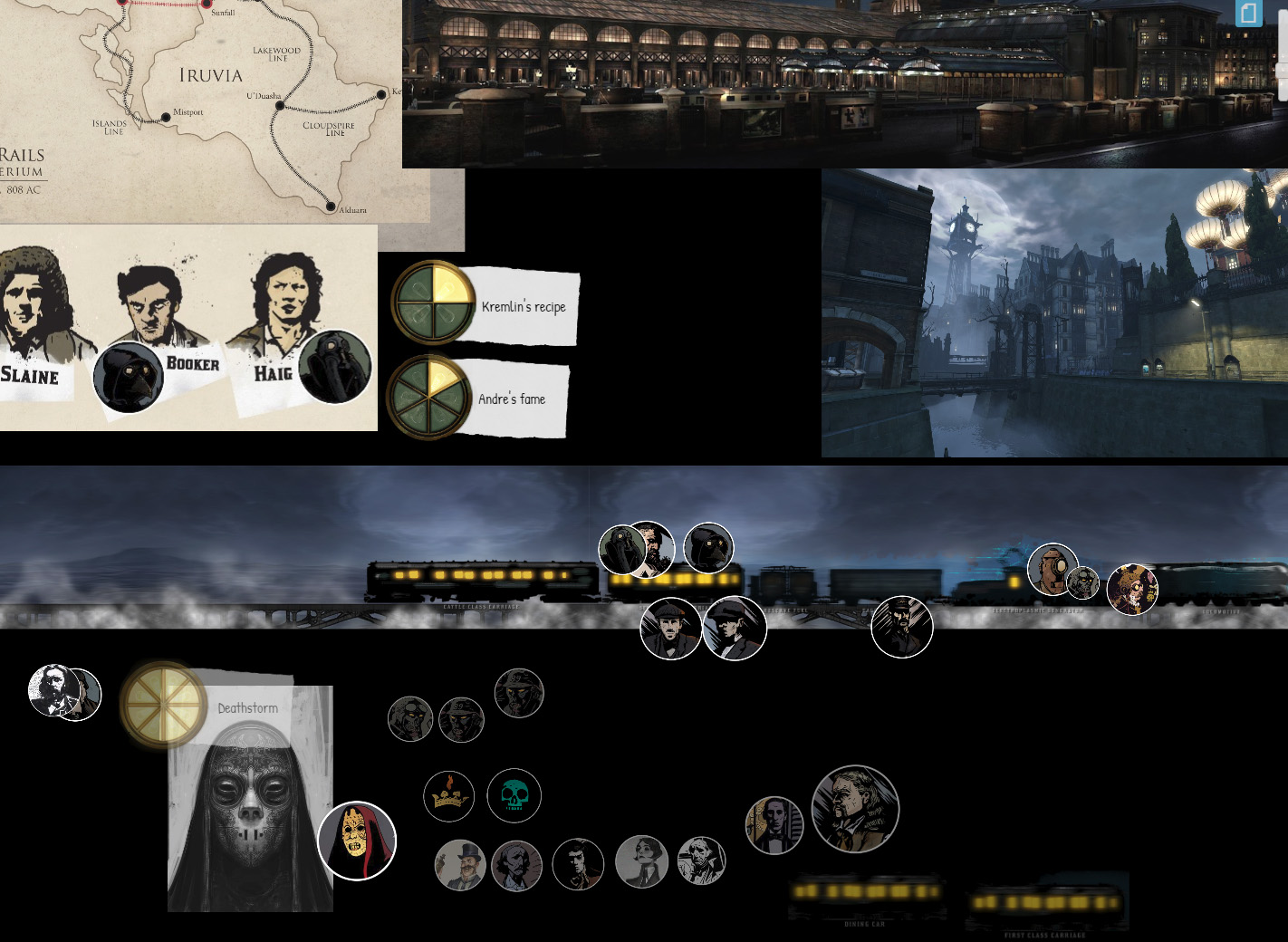Session 2 of our Ghost Lines prequel game – I think we’re starting to get the hang of it! It’s an interesting system to run; there’s good bones here and it works well when you bolt on mechanics from other systems (I’ve been using clocks from BitD and some of the Gauntlet’s Dungeon World procedures).
This session a series of bad rolls meant that the deathstorm came back as the train ran out of lightning oil. They managed to get the train going again thanks to the Owl’s spare lightning oil canister, but they lost all the freight carriages and their mentor Gulliver.
A fun, tense session (with help from a good old clock).
We also had a few weeks of downtime in Doskvol, getting a flavour of the city. One bull is doing some muscle work for the lamplighter union, who want him to make an inventor “disappear” on his next train journey (the inventor claims to have invented a stable lightbulb) . They also sold a ghost on the black market to Fat Rat & Grimm, Investors. Finally, the third bull caught up with his new friend Ragnar Ironborn – Ragnar can help him get the ghost-thistle tea recipe he’s looking for, in exchange for a little favour; helping smuggle a friend out of exile into Skovlan, a man by the name of Aldric…



The design work you put in to these is just bonkers. I’m especially a fan of your light-clocks.
Michael Elliott Cheers! That reminds me, I’ve been meaning to share those clock graphics online…
The clocks are great (the rest, too) and I like this cool Death Eater mask. Great stuff!
I’d love to see all the add-on mechanics you used, as I’ve always liked Ghostlines but felt there was just a bit more fleshing out needed to really make it sing. Also, that newspaper is killer. What did you make it in?
Jason Shea Oh thanks – that’s all in Photoshop.
I might write this up in a tidier fashion and share my generic prep doc (which has a bunch of impressions and events that I draw on), but off the top of my head;
– Clocks and a loose version of position/effect from Blades. Clocks are really handy for getting everyone on the same page about any given threat, and position/effect is pretty easy to loosely hack in; if someone chooses “create an opportunity”, the next person to exploit that opportunity ticks more clock segments. If someone has a heavy lightning hook, they tick more clock segments than a regular lightning hook. And so forth. For position, it simply means that I modify how hard my GM move is on a partial success or miss based on their fictional position before rolling. This is standard PBTA GM practice anyway, but I find it helps to have it named and defined.
– I use most of the tables for NPCs/locations/events from Blades in the Dark rather than Ghost Lines, since they’re more developed.
– I had each player choose a drive for their character. There are no XP rewards for this and a drive is loosely defined, but they help give the characters motivations and story arcs outside of busting ghosts. Our examples were a street urchin who wants to start smuggling, a nobleman wanting to become a famous celebrity linebull in the newspapers, and Booker just wants the excuse to travel the world; he’s hoping to piece together his grandfather’s lost hallucinatory bootleg brew recipe.
– I use Jason Cordova’s “Polling the Table” and “Paint the Scene” procedures. Polling the Table (which is basically just asking what each character wants to do in the scene ahead before it begins) is super useful for everything from figuring out the flow of a ghost-engagement to the linebulls sniffing around the train during downtime. Painting the Scene is a nice way to collaboratively build our version of the deathlands and how ghosts work together.
– We’ve been using the Die of Fate from World of Dungeons a lot. As you say, Ghostlines is a pretty barebones system and the Die of Fate is an easy way to plug any gaps. The player rolls 1d6 – low numbers are ill-fortune, high numbers are good fortune (or at least not misery). I use it for everything from weather and random ghosts on the train through to downtime activities that aren’t covered by the core stats (e.g. the players rolled the Die of Fate when they were trying to sell a captured ghost on the blackmarket – that one roll covered everything from whether they got into trouble through to how much stash they made).
This looks real fun. About those clock images…
Eric Herwaldt done! https://plus.google.com/109817499382146310869/posts/j2EKAr6wLTz